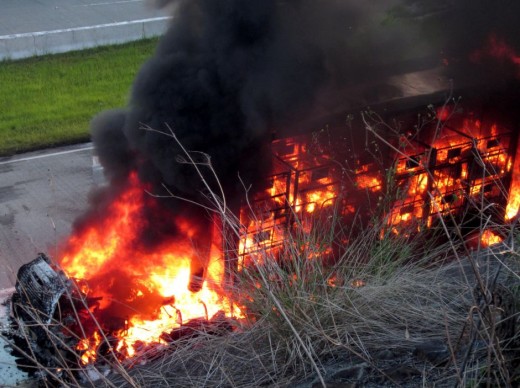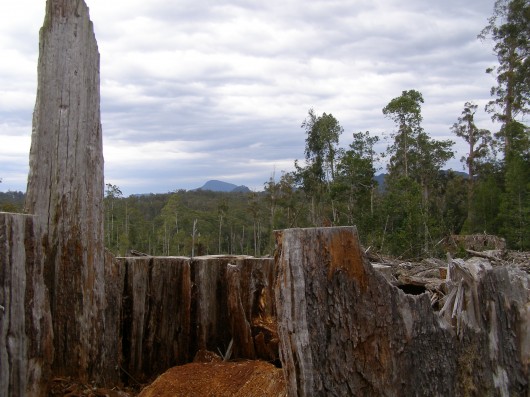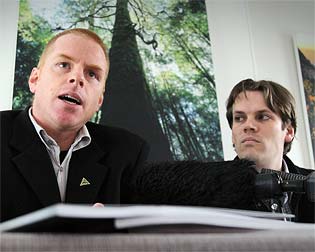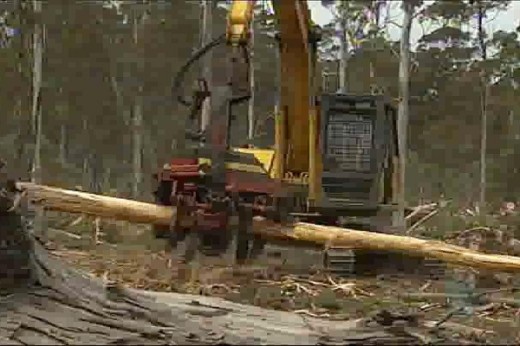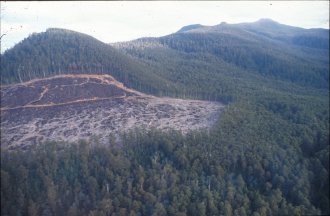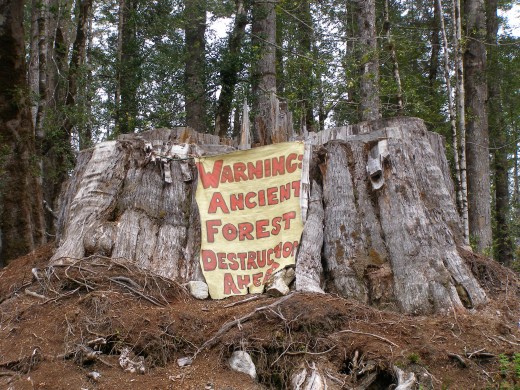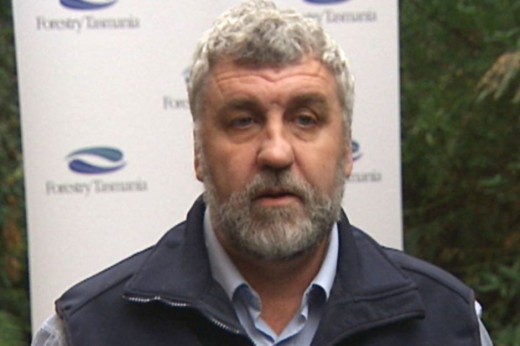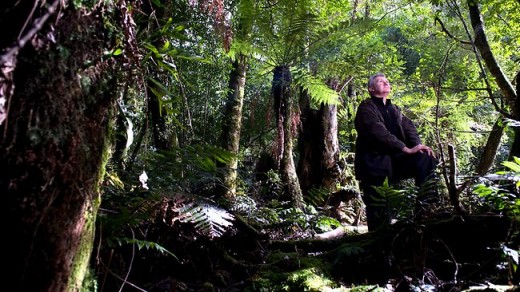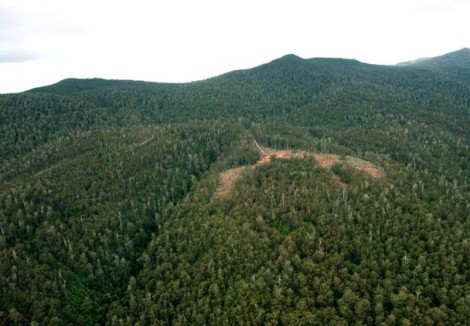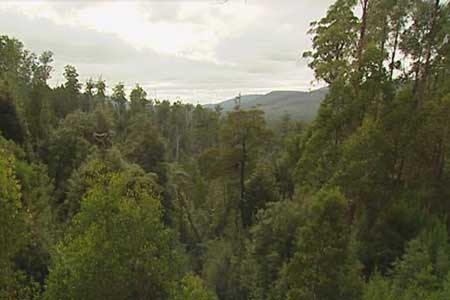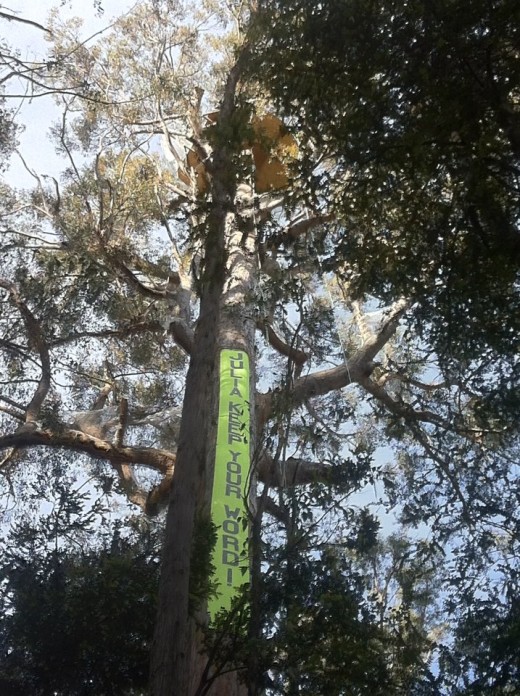‘Trucking Expressway’ ruining Blue Mountains
Wednesday, December 21st, 2011There is a ‘baby boomer‘ political penchant to encourage more and more freight to travel by truck, which has dominated Australian Government transport planning for the past sixty years since World War II.
It is a short-term tactical stop-gap measure. Compared with rail freight, road linehaul for large volumes, over long distances, in the long term is price uncompetitive, and Peak Oil driving up fuel costs will eventually prove road linehaul a strategic economic blunder.
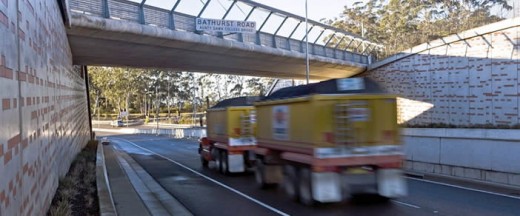 Speeding B-doubles increasingly dominate the highway over the Blue Mountains
‘Woe betide anyone who gets in my way!‘
(Photo by Editor, free in public domain)
Speeding B-doubles increasingly dominate the highway over the Blue Mountains
‘Woe betide anyone who gets in my way!‘
(Photo by Editor, free in public domain)
.
Yet ‘road-centric’ freight policy dominates the infrastructure planning, simply because it is being driven by the self-centred vested interests of the trucking industry – influenced (read ‘bought‘) by ongoing substantial monetary donations (read ‘bribes’) to the electoral campaigns of alternating Labor and Liberal governments. Visit ^http://democracy4sale.org/ and choose either:
.
Money talks, hence the political penchant to favour road freight. Whereas rail, entrenched as a government monopoly, has long denied any community say. Rail has become the Cinderella to Road where only a small honourary volunteer lobby, the Australasian Railway Association (ARA) has not the funds to compete against the collective corporate might of trucking donors. Read about the ARA: ^http://www.ara.net.au/site/index.php
The Liberal-Labor Party’s Auslink National Transport Plan since 2004 professed ‘a new strategic framework for the planning and funding of Australia’s roads and railways to meet long term economic and social needs.’ However, in reality the funding has all but gone into building bigger and more highways.
News is, we are about to enter the year 2012, so we should have advanced somewhat from post-war trucking thinking.
Yet in the Blue Mountains, west of Sydney, well over $1 billion is forecast to be spent to build a massive highway viaduct and tunnel; simply so that larger and faster trucks can cart freight, fuel and ore over the Blue Mountains and to bypass the village of Mount Victoria. The fact that a rail line following a similar route exists and has long been used to cart copious quantities of coal over the Blue Mountains, is ignored by a truck-centric political mindset. The planned Mount Victoria bypass is just one of the multiple ongoing highway widening sections being constructed by Roads and Traffic Authority (RTA) contractors over the Blue Mountains and ultimately extending from Penrith in Sydney’s outer metropolitan west to the New South Wales central-west regional town of Orange, 250km away.
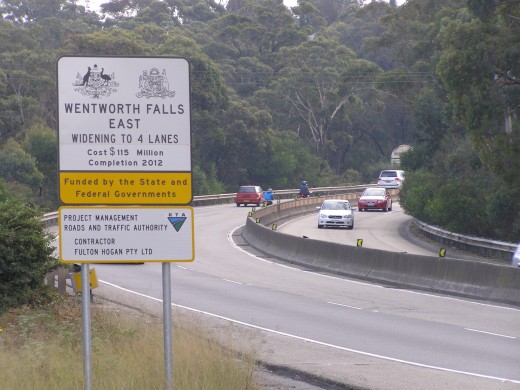 Great Western Highway, Wentworth Falls, March 2010
This trucking section just $115,000,000 (pre-blowout estimate)
(Photo by Editor, free in public domain)
Great Western Highway, Wentworth Falls, March 2010
This trucking section just $115,000,000 (pre-blowout estimate)
(Photo by Editor, free in public domain)
.
The widening of the highway has caused the destruction of much native vegetation and has ruined the bushland amenity of the villages and towns of the Central Blue Mountains. Construction has caused irreversible sediment contamination of many Blue Mountains waterways that drain from the highway ridgeline downstream into the Blue Mountains National Park and World Heritage Area.
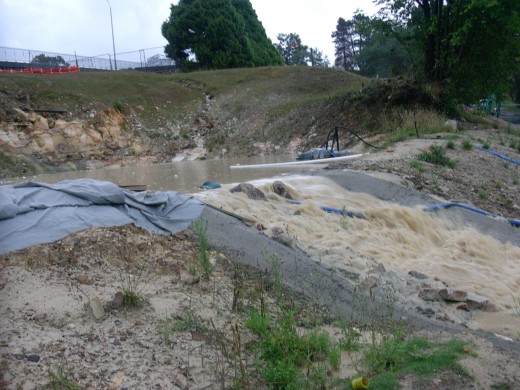 Leura, January 2006
– collateral stormwater pollution of downstream creeks to serve the Trucking Expressway
(Photo by Editor, free in public domain, click photo to enlarge)
Leura, January 2006
– collateral stormwater pollution of downstream creeks to serve the Trucking Expressway
(Photo by Editor, free in public domain, click photo to enlarge)
.
Since 1996, the widening of the Great Western Highway over the Blue Mountains has cost over a billion dollars already. Yet the highway runs parallel to an existing dual rail line, which for the most part runs right alongside one another. One justification argued for the massive cost and widening of the highway is to relieve traffic congestion for motorists, but there is a low population base in the Blue Mountains as settlement is confined to the ridgeline over the Blue Mountains where the highway and rail run together. Steep terrain either side prevent a large population expansion.
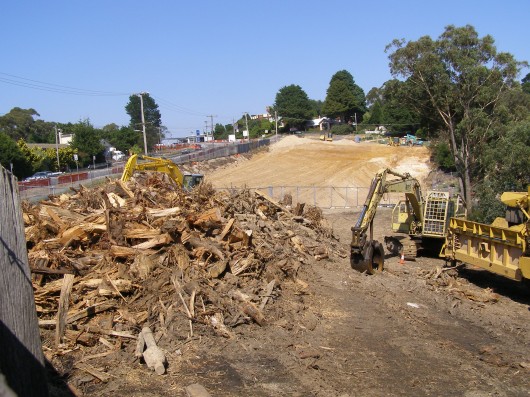 Katoomba, May 2009
– collateral vegetation damage to serve the Trucking Expressway
(Photo by Editor, free in public domain, click photo to enlarge)
Katoomba, May 2009
– collateral vegetation damage to serve the Trucking Expressway
(Photo by Editor, free in public domain, click photo to enlarge)
.
Before construction began, the only systemic traffic congestion on the highway was at weekends when tourists from Sydney ventured west in their cars. Spending billions to encourage domestic regional tourism has not been the real justification. The real justification has been and continues to be to encourage more truck freight along the Great Western Highway.
Yet the public is still waiting for a cost-benefit analysis, a calculation of any return on investment, an end-to-end journey analysis of the freight options, an holistic comparison to rail.
Instead, not only has there been a road-only freight focus, the trucks have got bigger. Governments are now permitting and encouraging the use of 19 metre ‘B-doubles’ along the highway. It is only a matter of time before 26 metre B-doubles turn up. In Victoria they are permitting B-triples – basically road-trains! Successive Labor and Liberal governments at both national and state level have maintained a truck-centric mindset since the 1980s when the NSW Greiner Government abandoned and close down much of the State’s rail infrastructure, including the closure of rail depots at Valley Heights and Junee.
This baby boomer political penchant has been encouraged and lauded by baby boomer himself, Bob Debus, long-time Labor politician for the NSW seat of Blue Mountains then the Federal seat of Macquarie, both covering the Blue Mountains region. Bob Debus has since retired, yet the Labor boomer mindset perpetuates with its truck-centric fervour.
.
“It is with dismay that I watch the Mountains stand by as the RTA fulfills Bob Debus’ promise of an “upgraded” highway (read Trucking Expressway) – by his own admission – built to carry 26m B-double trucks. The RTA admits that when the western container hubs are finished they will generate 4000 extra B-double movements per day. Parked end to end they would stretch 102 km – every day! Goondiwindi, Toowoomba and many other towns don’t allow them but we will see them roaring through every Mountains town – past schools, shops and homes.”
.
~ Dennis Plink, Hartley Vale (letter ‘B-double agenda‘ in Blue Mountains Gazette, 20090304, p.8..
The widening of the highway into a trucking expressway is wrecking the Blue Mountains. And certainly, those trucks have increased – in number, in size and length and in speed. These bigger, faster trucks are not policed. They are turning the Great Western Highway into a dangerous death zone.
 Speeding B-Double truck overturns on Lapstone Hill
– at an already widened section of the Trucking Expressway
Zoom, zoom, zoom!
(Photo by Top Notch Video).
Speeding B-Double truck overturns on Lapstone Hill
– at an already widened section of the Trucking Expressway
Zoom, zoom, zoom!
(Photo by Top Notch Video).
Last July, on the highway at Lawson near Queens Road, truck driven by a 66-year-old Murrangaroo man collided head-on with an eastbound car trapped a female passenger, followed by a separate collision between a truck and a car near Boland Ave at Springwood. On Friday, 29th July 2011 on Lapstone Hill the driver of a semi-trailer failed to negotiate a left-hand bend while travelling east and crashed into the concrete median barrier. The impact caused the truck’s trailer — containing a full load of bark — to tip over the barrier and slide a short distance into the path of a westbound Mitsubishi Lancer, driven by a 30-year-old Hazelbrook woman, who remained trapped before being rushed to Westmead Hospital. Traffic chaos ensued as all westbound lanes were closed for more than eight hours and one eastbound lane also shut for the clean-up operation. Lapstone Hill is one of the widened sections of the highway.
.
[Source: ‘Blue Mountains highway mayhem’, by Shane Desiatnik, Blue Mountains Gazette, 20110803, ^http://www.bluemountainsgazette.com.au/news/local/news/general/blue-mountains-highway-mayhem/2246694.aspx?storypage=0].
Increasingly we are reading in local newspapers of road trauma involving trucks. Across Australia, during the 12 months to the end of March 2009, 248 people died from 229 crashes involving heavy trucks or buses. These included:
- 138 deaths from 124 crashes involving articulated trucks (semi-trailers, B-doubles, B-triples)
- 90 deaths from 86 crashes involving heavy rigid trucks
- 22 deaths from 21 crashes involving buses.
.
[Source: ‘Fatal Heavy Vehicle Crashes Australia: Quarterly Bulletin, January-March 2009’, Summary, ^http://www.infrastructure.gov.au/roads/safety/publications/2009/fhvca_q12009.asp].
.
Here are just some of the tragic road trauma incidents involving trucks across Australia over the past year:
.
‘Truck burns at Yelgun’ … two days ago!
Flames engulf a postal truck at Yelgun on the NSW north coast on December 18, 2011. The driver stopped the truck after noticing smoke pouring from the engine bay. He collected his belongings and departed the vehicle before the flames took hold.
.
[Source: ‘Truck burns at Yelgun”, by Kalindi Starick, ABC, 20111220, ^http://www.abc.net.au/news/2011-12-19/flames-engulf-a-postal-truck-at-yelgun-on-the-nsw-north-coast/3737752].
‘Teenage driver killed in truck collision’…two days ago
.
One woman was killed and five people were injured in two accidents involving B-double trucks.
- Engineers were called to the scene of a dramatic accident on the Gateway Motorway at Boondall in Brisbane about midday yesterday, when a B-double truckexploded after it and a car collided.
- On the Bruce Highway near Rockhampton, a 19-year-old woman died and four people were injured when a car and a B-double truck collided. Police said the station wagon tried to turn into the southbound lanes of theBruce Highway at Marmor just before 8pm on Friday when the car and truck, whichwas travelling in the northbound lane, collided. The 19-year-old driver was killed, while her three female passengers, two aged19 and one aged 18, were taken to Rockhampton hospital. The three are in a stable condition. The 65-year-old driver of the B-double was taken to hospital for precautionary treatment and has been released.
.
[Source: ‘Teenage driver killed in truck collision’, by Date: December 18 2011, Ellen Lutton, 20111218, Sydney Morning Herald, ^http://www.smh.com.au/queensland/teenage-driver-killed-in-truck-collision-20111217-1p0ax.html?skin=text-only].
‘Truck crash closes Melbourne freeway’
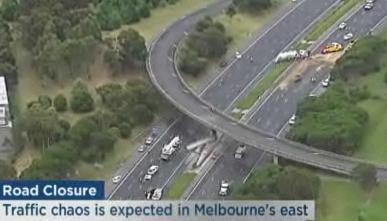 Melbourne’s Monash Freeway is closed in both directions after a semi-trailer crashed into a bridge pylon in the suburb of Mulgrave in the city’s south-east.
Melbourne’s Monash Freeway is closed in both directions after a semi-trailer crashed into a bridge pylon in the suburb of Mulgrave in the city’s south-east.
.
[Source: ‘Truck crash closes Melbourne freeway’, ABC, 20111213, ^http://www.abc.net.au/news/2011-12-13/truck-crash-closes-melbourne-freeway/3727918].
‘Truckie quizzed over fatal crash’
Two people have died in a crash on the Pacific Highway near Yamba on the NewSouth Wales north coast.
A 62-year-old man and a 51-year-old woman from the Leeton area died when two cars collided about 11:00am (AEDT) today. A woman and three children who were in the other car have been taken to the Coffs Harbour Hospital. Police say a truck driver who was involved in the accident but failed to stop, was later pulled over at Ballina. Police are interviewing him. Rebecca Walsh, from the Traffic Management Centre, says the Pacific Highway is closed in both directions and vehicles are being diverted along the Summerland Way at Grafton.
. [Source: ‘Truckie quizzed over fatal crash’, ABC, 20111111, ^http://www.abc.net.au/news/2011-11-11/truckie-quizzed-over-fatal-crash/3660874].
‘Chemical alert after truck rolls in Blue Mountains’
.
Fire crews are battling to contain a major chemical spill on the Great Western Highway at Katoomba in the Blue Mountains, after a truck overturned and 20,000 litres of a bright green industrial chemical poured out.
Protective bunds have been built around the spill site to stop the chemical, which is possibly a type of hydraulic fluid, reaching the iconic Leura cascades. The chemical is described as biodegradable, but it can be a toxic irritant to skins and eyes if touched.
Six fire crews were at the site at 5pm, plus a hazardous materials unit from St Marys, a spokesman for Fire and Rescue NSW said.National Parks rangers, Blue Mountains council staff and fire crews are monitoring the extent of the spilled fluid, some of which entered the drainage system. Council staff have poured gravel around the edge of the spill area to try and contain it. The truck rolled over at about 2pm, and the driver’s condition is unknown, although he or she was understood to not have been trapped in the vehicle.
.[Source: ‘Chemical alert after truck rolls in Blue Mountains’, by Ben Cubby, Environment Editor, 20111026, Sydney Morning Herald, ^http://www.theleader.com.au/news/national/national/environment/chemical-alert-after-truck-rolls-in-blue-mountains/2337200.aspx] .Editor: Subsequent reports by a Katoomba resident reported observing the green hydraulic fluid flow in quantities down Govetts Creek. The contaminant would probably have ended up in the World Heritage Area of the creek within the Grose Valley, but would the RTA, Blue Mountains Council or the National Parks Service care?
‘.
‘Truck overturns at Tabbimoble’ (Maclean)
.A woman suffered minor injuries when the truck she was driving overturned on the Pacific Highway at Tabbimoble yesterday morning.
The B-double truck carrying general freight was heading north on the Pacific Highway and was about 2km south of the New Italy complex and 25km north of Maclean when it rolled shortly before 5am. The 46-year-old woman who was at the wheel of the Volvo semi-trailer complained of back pains and was taken by ambulance to Lismore Base Hospital. The highway was partially blocked for four hours while emergency service cleared away the debris. The accident occurred on what has become a notoriously black stretch of road where several fatalities have occurred in recent years.
.
.
‘Cyclists mowed down by truck’
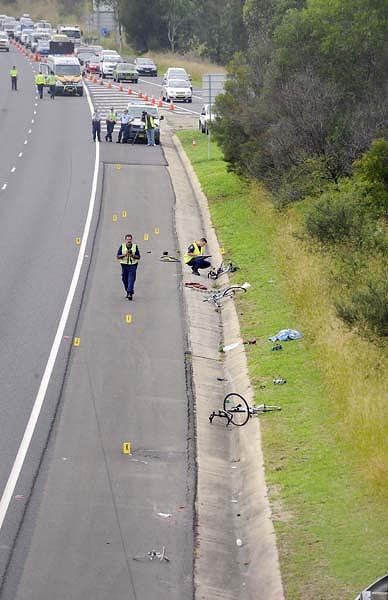 M4 Motorway (aka Trucking Expressway) on approach to the Blue Mountains
Photo: Adam Hollingworth
M4 Motorway (aka Trucking Expressway) on approach to the Blue Mountains
Photo: Adam Hollingworth
.
One man has died after a truck veered into a group of cyclists on the M4 motorway.
Fatigue may have caused a truck driver to veer into the breakdown lane and mow down a group of cyclists, killing one, on the M4 in Sydney’s west. Police said a group of four cyclists were riding in the breakdown lane of the M4 near the Northern Road overpass at South Penrith when they were struck by a B-double truck about 7.40am today. A male cyclist died and the three others sustained serious injuries. The injured were taken to Nepean Hospital.
A WorkCover spokesman said a preliminary investigation was under way to ascertain whether driver fatigue caused the accident. Police said the male truck driver was taken to hospital for mandatory blood and urine tests. Police are investigating the cause of the crash.
.
[Source: ‘Cyclists mowed down by truck’, Sydney Morning Herald sourcing AAP , 20100410, ^http://www.smh.com.au/nsw/cyclists-mowed-down-by-truck-20100410-rz7v.html].
‘Overtaking gamble cost highway driver his life, police believe’
.
One person has died after a truck carrying chemicals exploded after colliding with a car on the NSW north coast this morning.
Police believe a car driver’s early morning gamble in trying to pass a B-double truck on a no-overtaking stretch of the Pacific Highway cost him his life. The sedan was travelling southbound at Warrell Creek just before 4am when it appeared to pull out into the oncoming lane to overtake the truck. It then crashed head-on into a second, northbound, B-double carrying chemicals, Senior Constable Brian Carney of the Mid North Coast Crash Investigation Units aid.
.
[Source: ‘Overtaking gamble cost highway driver his life, police believe’, by Glenda Kwek, 20110405, ^http://www.smh.com.au/nsw/overtaking-gamble-cost-highway-driver-his-life-police-believe-20110405-1cz01.html].
‘Exploded fuel tanker closes Pacific Highway’
The Pacific Highway on the New South Wales north coast will be closed until New Year’s Day while crews clear a fuel tanker that exploded and killed the driver.
The tanker hauling 40,000 litres of fuel overturned and exploded on what is regarded by truckies as a notorious stretch of the highway, near Tintenbar, 10 km north of Ballina.
Authorities have set up a one-kilometre exclusion zone around the burning tankerand more than 100 firefighters equipped with breathing apparatus were sent to the scene.The ambulance service says the truck driver was killed in the blast, while two people have been freed from a nearby car after being trapped when powerlines came down on their vehicle. The second trailer of the B-double was thrown into a paddock where it leaked fuel into a nearby wetland, and police still cannot get to the cabin of the burnt truck where the driver’s body remains inside.
Another tanker driver, Gary, says the driver is one of their own but they do not know who.”It is sad to be holed up on the side of the road like this. And it’s sad for a driver that’s not going to go home to his family,” he said.
The truck was laden with diesel and unleaded fuel, which has now been mostly contained. Police say they will not be able to assess the damaged road until the scorched truck is moved, but they expect the Pacific Highway to be closed for the rest of today. Six other trucks are banked up behind the accident site unable to turn around.
.
[Source: ‘Exploded fuel tanker closes Pacific Highway’, ABC, 20101231, ^http://www.abc.net.au/news/stories/2010/12/31/3104386.htm?site=goldcoast].
‘Truck lobby donations seem more important than people’s lives!‘
.
~ Dennis Plink, loc. cit.
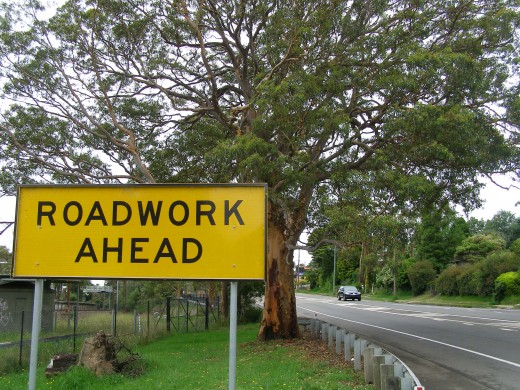 Native Angophora 300 years old.
The RTA’s Environment Manager says it’s in the way – Chip it!
– collateral damage for the Trucking Expressway
…note railway line on left
Native Angophora 300 years old.
The RTA’s Environment Manager says it’s in the way – Chip it!
– collateral damage for the Trucking Expressway
…note railway line on left
